Name
Tallinn. The name derives from Taani Linn (Danish fortress) which was mainly used during the late medieval age. Even older is the German name for Tallinn Reval, which again derives from the name for the province of Rävala Before that, the place - at that time not yet a town - was known as Lindanise or in Russia as Kolyvan respectively.
Location

| ||
| Tallinn |
Tallinn is located in the North of →Estonia within the boundaries of the province of Põhja-Eesti (Northern Estonia). The old town straddles a protected bay of the Gulf of Finland. On the other side of the Gulf lies Helsinki, which is only 85 km away from Tallinn. Tallinn has not only a waterfront in the north but also in the south, namely the Ulemiste Järv (järv = lake). The old city centre is only a few hundred metres away from the sea shore. The newer part of the town and some suburbs stretch a few kilometers to the south near and around the lake.
Population
Estonia's capital is a comparetively small town with 400,000 inhabitants only. But this again means that every third Estonian lives in the capital. Since many non-Estonians left the town after Estonia gained independence, the population decreased considerably.
Orientation

| ||
| Panorama of Tallinn's old city centre I |
Tallinn has a very distinctive, ovally shaped old city centre called Vanalinn, which is in wide parts still surrounded by a almost perfectly preserved town wall and a few parks. From the north to south, the core is around 1 km long, from west to east on its widest point 750 metres or so. The old town then is divided into the large, lower castle town and the upper castle town, called Toompea. The latter is home to the parliament and other important administrative buildings.
The small dead-end station of Tallinn, called Baltijaam, lies a few hundreds meters away northwest of the old town near a small park. The large ferry terminal and the heliport are also very close - it's only a stone's throw away north of the old town. To be more precisely, there are two ferry terminals - the small Linnahallsadam (see below) and - close to the east of it - the larger Reisisadam, from where ferries to Helsinki and Stockholm start.
The Bussijaam (bus terminal) is further away but still within walking distance and can be found southeast of the centre on Str. Lastekodu. From there it's only 200 m to the next tram station. Line 2 and 4 will bring you closest to the old town. Long distance coming from and going to →Riga stop at the entrance to the old town centre as well - the stop will be announced aboard. That bus stop is close to the theatre next to Tammsaare-Park. Just cross the broad street there and you'll find yourself already in the heart of the town centre.

| ||
| Panorama of Tallinn's old city centre II |
Tallinna Lennujaam, the international airport, is also close - it's 12 km away from the old town, with bus No 2 running between the airport and the centre. Most attractions concentrate in a rather small, compact area, making it very easy to explore the town on foot only without getting lost.
History
First smaller settlements and a tiny fortress were already mentioned before the year 1000 in and around present-day Tallinn. Since the 11th century, a fortress called Lindanise dominated the castle hill, today known as Toompea. However, the town itself wasn't mentioned before 1219, when the Danes landed at Tallinn and defeated the Estonians in Lindanise. As a result, the Danes built their own fortress on Toompea, which was logically named Taani Linn (Danes' Fortress) by Estonians.
The further history of the fortress as well as the castle town below it was less dominated by Estonians but mostly by Danes and Germans. At the end of the 13th century, the town, then known as Reval, became a member of the Hanseatic League, playing an important role in the trade between the League and the East. In 1346, the Danes finally sold Northern Estonia including Tallinn to the Teutonic Knights. The main parts of the defense system in and around the castle where mostly installed soon after that. Thanks to the vibrant trade with the East, Reval was soon to become an influential and wealthy town - entirely administered by Germans. Mainly at that time, many German words entered the Estonian language. Even today, many place names in Tallinn are from German origin. The town experienced its first heyday in the 15th century, where many churches were added to the old town. From the beginning of the 16th century, protestants gradually took over in Tallinn and the wider region around it.
The Livonian War during the 16th century reached Estonia and Tallinn as well. As a result of the war, Tallinn became Swedish in 1561. Shortly after that, Russia tried twice to occupy the town but they couldn't succeed. Meanwhile, Tallinn's role as an important trade town slowly eroded, while it developed more and more into a strong fortress town. During the 17th century, Tallinn was facing the pest and desastrous fires. During the Great Northern War at the beginning of the 18th century, the town surrendered without fighting to the Russian Tsar - from today's perspective a wise decision, since the surrender spared the town from larger damage. After the war, the town was about to remain Russian property for a long time and gradually lost its privileges.
Later, the industrialisation and the construction of a port underlined Tallinn's strategic importance. Already in 1870, a railroad connected the town with St. Petersburg. At the beginning of the 20th century, the Estonian national movement grew stronger. But things turned bad during the turmoil of World War I. In 1918, almost at the end of the war, Germany occupied Tallinn but soon lost it. Next, a fierce fight between Bolsheviki and Nationalists erupted - with a victory for the latter. And so, Tallinn became the capital of the Republic of Estonia from 1918 to 1949. But in 1940, the Soviet Union took the town. Shortly after, the German Wehrmacht took over. They stayed until 1944 before the Red Army drove them out again. Although the Red Army bombed the town during the last campaign, little damage was done to the old town. But from the end of the 1940ies, Tallinn was declared off-limits for foreigners by the Soviet Union, so that virtually no one from outside the Soviet Union could enter the town for decades. In 1991, Tallinn was declared capital again when Estonia regained independence. Much has been done since then - to find traces of the communist era of Tallinn, visitors will have to go to the suburbs, and even there it's hard to find something that remains from Soviet times. For more information on history, see also the chapter on →History of Estonia.
Getting there / transportation
For detailled information on how to get there and away, see →Estonia: Transportation.
In Tallinn, the Tramm (tram) is the most convenient way to get around. Altogether there are five lines, serving also the train station, the bus terminal and surrounding the old town. There are also several busses. The price for a ticket is 10 EEK. Tickets must be purchased before boarding (which is different to other Ex-Soviet Union countries) and validated inside the carriage. Note that you'll have to pay a hefty fee of 600 EEK if caught without a valid ticket.
As in →Vilnius and →Riga, the entire old centre of town, known as Vanalinn, has been declared World Cultural Heritage by the UNESCO - of course not without reason. But the difference in the atmosphere of Tallinn as compared with Riga and Vilnius is quite remarkable. Although the modern part of town with its large bank buildings and hotels starts right outside the old town, it really feels like traveling back straight to the Middle Ages when in the old town. This is partially thanks to the old watchtowers and the rest of the city wall menacingly towering over the old town. The impressive city wall is best seen from the area northwest of the old town along Laboratooriumi Rd.. Another impressive view can be enjoyed from the Parliament direction Kiek in de Kök - not the only German place name in Tallinn (see also picture in the chapter on →Estonian History). The name resembles a distinctive North German dialect and means "Look in the kitchen", because watchguards could get a glimpse of the citizens' kitchen from the tower.
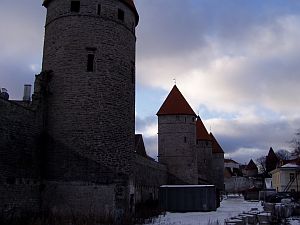
| ||
| City wall and towers along Laboratooriumi Rd. |
The south-western part of the old town is dominated by an elevated area known as Toompea. This part is sperated from the lower castle town by another strong fortification system and marks the oldest part pf Tallinn. There are only two ways to get to Toompea from the rest of the old town - the Pikk Jalg rd. or via a steep path known as Lühike Jalg. Toompea mostly consists of very narrow streets and is home to many embassies and administrative buildings. No doubt the huge Aleksander Nevski Katedraal (no translation necessary I presume) catches the eye of all visitors, since this building doesn't fit at all into the rest of the castle hill. The construction was ordered by the Tsar in 1901 to prove his power. The cathedral sits in front of the House of Parliament like a pitbull waiting for someone to sink its teeth in. Its appearance simply doesn't belong there. And so it's no surprise that some Estonians proposed to move the building somewhere else.
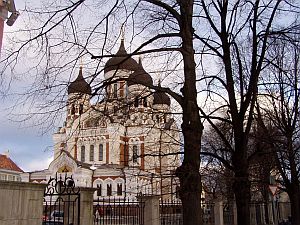
| ||
| The Alexander Nevski-Cathedral |
Talking about the parliament - this can be found inside Toompea Loss (loss = fortress) as well - as mentioned above, together with other administrative buildings and embassies. Unfortunately it's not allowed to enter the parliament. The old fortress occupies the entire south-western corner of the old town. More than any other building, the 50 m high tower Pikk Hermann ("Long Herman") dominates the castle and the surroundings.The castle itself was mainly built by the knights of the Teutonic Order and nowadays marks the political and historical heart of Estonia.
Another dominating structure on Toompea is the characteristic cathedral Toomkirik. This church was built by the Danes and is considered to be the oldest church in town. Especially charming - not only in Toompea but in the entire old town - are the countless tiny alleys, which are often to small for cars to pass through. And so it's a very relaxed and romantic place to stroll around and enjoy all the small, often colourful houses. Toompea lies about 25 m higher than the rest of the town - not much, but enough to have a great view from the observation spot Vaateplats in the north and another spot in the north-east over the harbour, the old town and the sea (see panorama above). Toompea is also home to the Eesti Kunstimuuseum (Kunst = German for "Arts"). Additionally, there are many small boutiques and private galleries along Lühike alley.
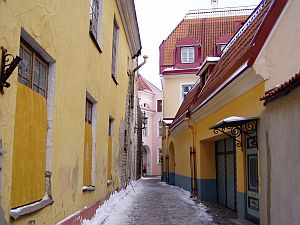
| ||
| One of the small alleys on Toompea |
The lower castle town known as All-linn is full of churches, museums, theatres, monasteries, souvenir shops etc. Almost exactly in the middle - typical for Medieval towns - lies the large Raekoja Plats (town hall square) featuring some posh cafés, restaurants and the beautiful old town hall. Behind the town hall, occupying the old dungeon (Raevangla), is an interesting permanent exhibition on photography, having very interesting old photos from Tallinn on display. There are plenty more museums around - from nature to Tallinn's history, Estonian history, maritime life and even a museum on hygiene - just to name but a few.
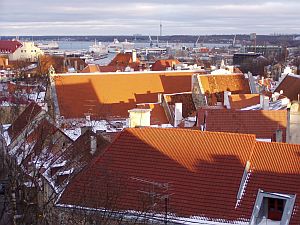
| ||
| View towards the harbour |
As already mentioned above, the numerous Klooster (monasteries) and Kirik (churches) make Tallinn a particularly interesting place. Definitely worth visiting is the Oleviste Kirik (St. Olaf Church) in the northern part of the old town. The construction began in the 13th century, with some major changes during the 15th century, after which it reached a respectable height of 159 (!) m - at that point of time by far the highest human-built structure on earth. Unfortunately, the church lost its tower later due to lightning strike and fire. The present form dates back to the year 1840, with a height of 124 m still very impressive and still the highest building in Tallinn (the TV tower is quite far away).
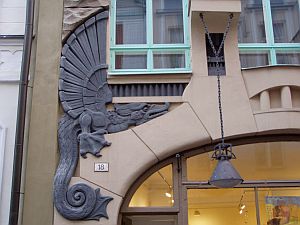
| ||
| There's no lack of interesting Art Noveau buildings in Tallinn |
The best way to explore Tallinn is to leave guidebooks at home and just stroll around. There's plenty to see in the old town - buildings from many centuries, tiny alleys, rather modern Art Noveau architecture with lovely details, drunken Finns - but that's another story. Since booze is much cheaper in Estonia than in Finland, many day- and night-trippers from beyond the sea can be seen in Tallinn - most of them not exactly sober at night. By the way - since many buildings are lit up in the old town, a walk at night can be highly recommended, too.
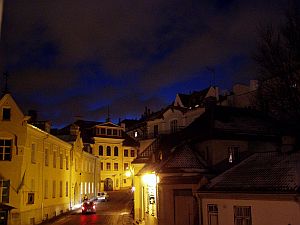
| ||
| Tallinn at night has its charme as well |
It's also worth to leave the old town and have a look at the rest of Tallinn. Right at the northern tip of the old town, below a massive tower called Paks Margareeta (Fat Margaret), there's the Estonia Memorial. This modern though impressive monument - a long, twisted arch made of obsidian, which is interrupted in the middle, is dedicated to the estimated 852 people who lost their lives on Sep 28 1994, when the ferry serving the Tallinn-Stockholm route sank within minutes in the middle of the Baltic Sea.
From the memorial, it's only a few hundred metres to the north to the Linnahall (Citizen Hall), a large and ugly chunk of concrete, with a heliport on the back of it (just in case that you haven't got change for the ferry and need to fly to Helsinki). From the citizen hall, smaller ferries run to the Finnish capital.
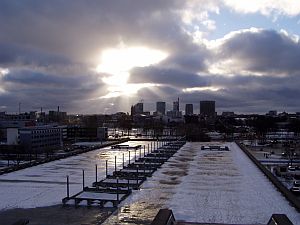
| ||
| View from the citizens hall towards the old town |
South-east of the old town, only separated by a wide road and a small park, starts the modern part of Tallinn. Just walk along Viru rd., pass the two towers left and right of the road and you'll find yourself in front of the 22 storey Hotel Viru, which is also home to a large shopping mall, a Swedish supermarket and more. Behind the hotel there are hyper-modern bank buildings, but if you walk further you'll soon get to the more-than-normal, slightly dirty Tallinn). Among the banks stands a simple but nice wooden church. Surprisingly, this is an Armenian Church. It's not the fact that it's an Armenian Church right in the middle of Tallinn - the →Armenian diaspora can be found everywhere - that surprises but the shape of the church, which doesn't really look Armenian at all.

| ||
| Armenian Church in front of one of the bank buildings |
Only 50 km east of the capital lies the 680 km² wide Lahemaa Rahvuspark - a national park mainly consisting of coast, forests and swamps. The national park is home to many in Europe almost extinct creatures such as the black stork, minks and more.
Compared with other places in the wider area (except Finland), Tallinn is comparetively expensive and that includes accommodation. Probably the cheapest option to stay near the old town is one of the hostels and hotels along Uus rd., which runs parallel to the east side of the old town. One of the places there is the Old Town Backpackers (Uus 14). This place doesn't have singles or doubles but only dormitories, charging 225 EEK (€ 16) per person. Among other things it offers a shared kitchen. 200 m north of it is the (Old Town) Hostel - appearantly a hostel (hotel?) with tradition and very nice interior. A night in a double room set us back 325 EEK (€ 21 Euro) per person. This hostel also has a TV room and an almost antique kitchen - the latter itself is a real attraction. Staff was very friendly and helpful when we stayed there. Address: Uus rd. 26, Tel: +372-(0)-6411 281. Email: info@oldhouse.ee, URL: www.oldhouse.ee.
Eating out cheap in the old town? No way. Especially due to the hords of tourists from Finland and Sweden, restaurant prices are among the highest in the Baltic states. However, one place should be mentioned here - the Hell Hunt in Pikk 39, less than 5 minutes on foot away from Uus rd. The place has an Irish Pub atmosphere and attracts many young Estonians and expats alike. Hell hunt brews its own beer and the food is quite reasonable, too. A sufficient supper including a few drinks will set you back around € 10. We've talked to some Estonians there and they all ensured us that the Hell Hunt is probably the best place in the old town for some good fun plus entertainment. It's also a great place to meet locals.
Of course it's also possible to buy your own food at super markets or to eat outside the old town - prices there are much lower and a good dinner can be as low as 3 to 4 Euro.
- www.tallinn.ee: Official website of Tallinn with plenty of useful information - comes in Estonian, Russian and English.
- www.tallinn.info: Design-wise a very interesting website dedicated to visitors of Tallinn.
Do you have or do you know a good website about Tallinn? Don't hesitate, let me know! After checking it, I would love to add it to the link list. You can submit a link by using the →contact form. Note that commercial websites will be treated differently.
©2024 Europe-East.com

 Albania
Albania Estonia
Estonia